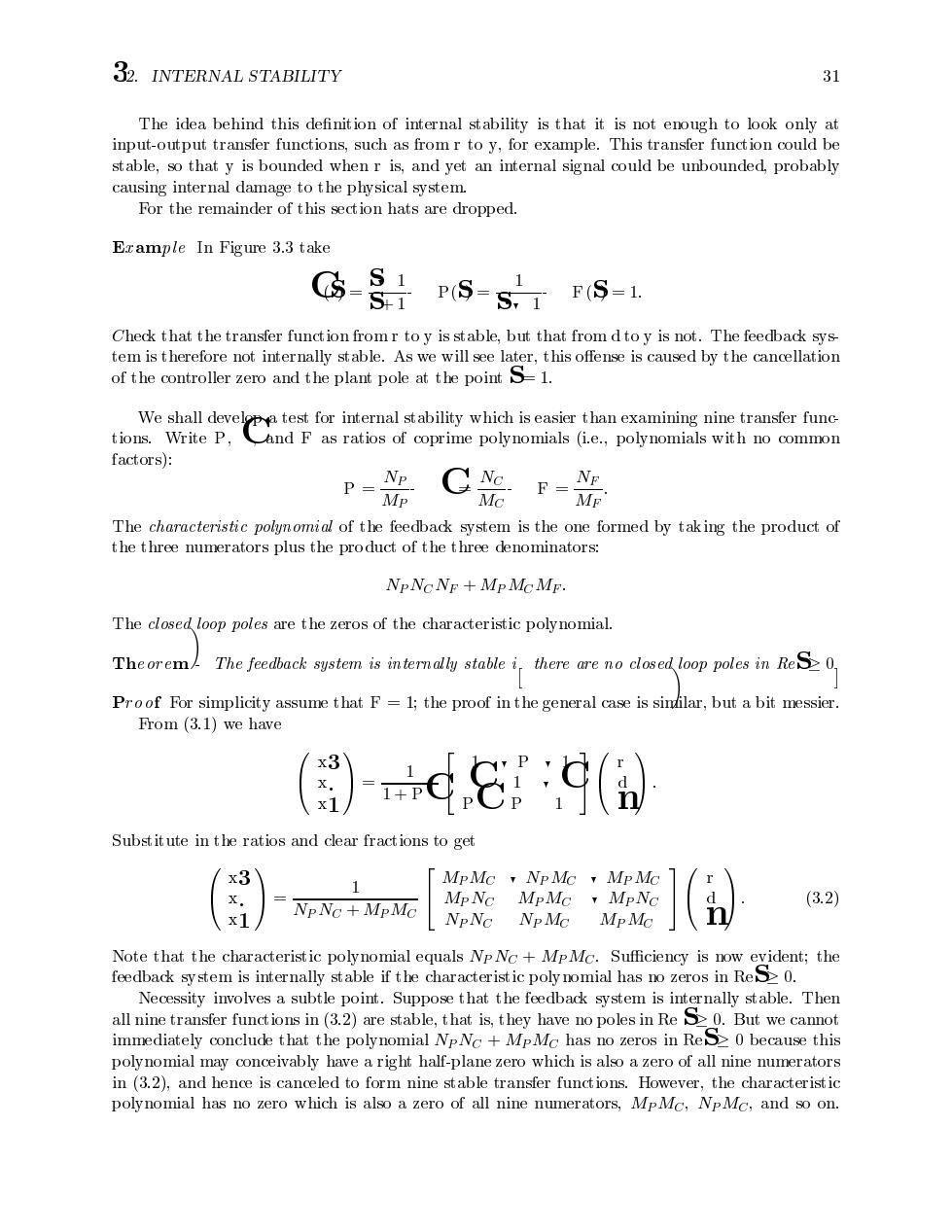正在加载图片...

32.INTERNAL STABILITY 31 The idea behind this definition of internal stability is that it is not enough to look only at input-output transfer functions,such as from r to y,for example.This transfer function could be stable,so that y is bounded when r is,and yet an internal signal could be unbounded,probably causing internal damage to the physical system. For the remainder of this section hats are dropped. Example In Figure 3.3 take -5 1 1 P(S-S:I F(S-1. Check that the transfer function fromr to y is stable,but that from d to y is not.The feedback sys tem is therefore not internally stable.As we will see later,this offense is caused by the cancellation of the controller zero and the plant pole at the point S-1. We shall develop aa test for internal stability which is easier than examining nine transfer func tions.Write P, and F as ratios of coprime polynomials (i.e.,polynomials with no common factors): P= Np. Nc.F-NE Mp Mc F The characteristic polymnomial of the feedback system is the one formed by taking the product of the three numerators plus the product of the three denominators: NPNCNF MPMCMF. The closed loop poles are the zeros of the characteristic polynomial. The orem∠ The feedback system is internally stable i there are no closed loop poles in Re Pro of For simplicity assume that F =1;the proof in the general case is similar,but a bit messier. From (3.1)we have :c(n Substitute in the ratios and clear fractions to get 1 MPMc NpMc MpMc MpNc MPMc MpNc (3.2) NPNc MpMc NPNC NpMc MPMo Note that the characteristic polynomial equals Np Nc+MpMc.Sufficiency is now evident;the feedback system is internally stable if the characterist ic poly nomial has no zeros in ReS0. Necessity involves a subtle point.Suppose that the feedback system is internally stable.Then all nine transfer functions in (3.2)are stable,that is,they have no poles in Re 0.But we cannot immediately conclude that the polynomial NpNc +MpMc has no zeros in ReS=0 because this polynomial may conceivably have a right half-plane zero which is also a zero of all nine numerators in (3.2),and hence is canceled to form nine stable transfer functions.However,the characteristic polynomial has no zero which is also a zero of all nine numerators,MpMC,NpMc,and so on. INTERNAL STABILITY
The idea behind this denition of internal stability is that it is not enough to look only at inputoutput transfer functions such as from r to y for example This transfer function could be stable so that y is bounded when r is and yet an internal signal could be unbounded probably causing internal damage to the physical system For the remainder of this section hats are dropped Example In Figure
take Cs s s P s s F s Check that the transfer function from r to y is stable but that from d to y is not The feedback sys tem is therefore not internally stable As we will see later this oense is caused by the cancellation of the controller zero and the plant pole at the point s We shall develop a test for internal stability which is easier than examining nine transfer func tions Write P C and F as ratios of coprime polynomials ie polynomials with no common factors P NP MP C NC MC F NF MF The characteristic polynomial of the feedback system is the one formed by taking the product of the three numerators plus the product of the three denominators NP NCNF MPMCMF The closedloop poles are the zeros of the characteristic polynomial Theorem The feedback system is internal ly stable i there are no closedloop poles in Res Proof For simplicity assume that F the proof in the general case is similar but a bit messier From
we have x x x
A P C P C C P C P r d n
A Substitute in the ratios and clear fractions to get x x x
A NP NC MPMC MPMC NPMC MPMC MP NC MPMC MP NC NP NC NPMC MPMC r d n
A
Note that the characteristic polynomial equals NP NC MPMC Suciency is now evident the feedback system is internally stable if the characteristic polynomial has no zeros in Res Necessity involves a subtle point Suppose that the feedback system is internally stable Then all nine transfer functions in
are stable that is they have no poles in Re s But we cannot immediately conclude that the polynomial NP NC MPMC has no zeros in Res because this polynomial may conceivably have a right halfplane zero which is also a zero of all nine numerators in
and hence is canceled to form nine stable transfer functions However the characteristic polynomial has no zero which is also a zero of all nine numerators MPMC NPMC and so on��������������������������������������������������������